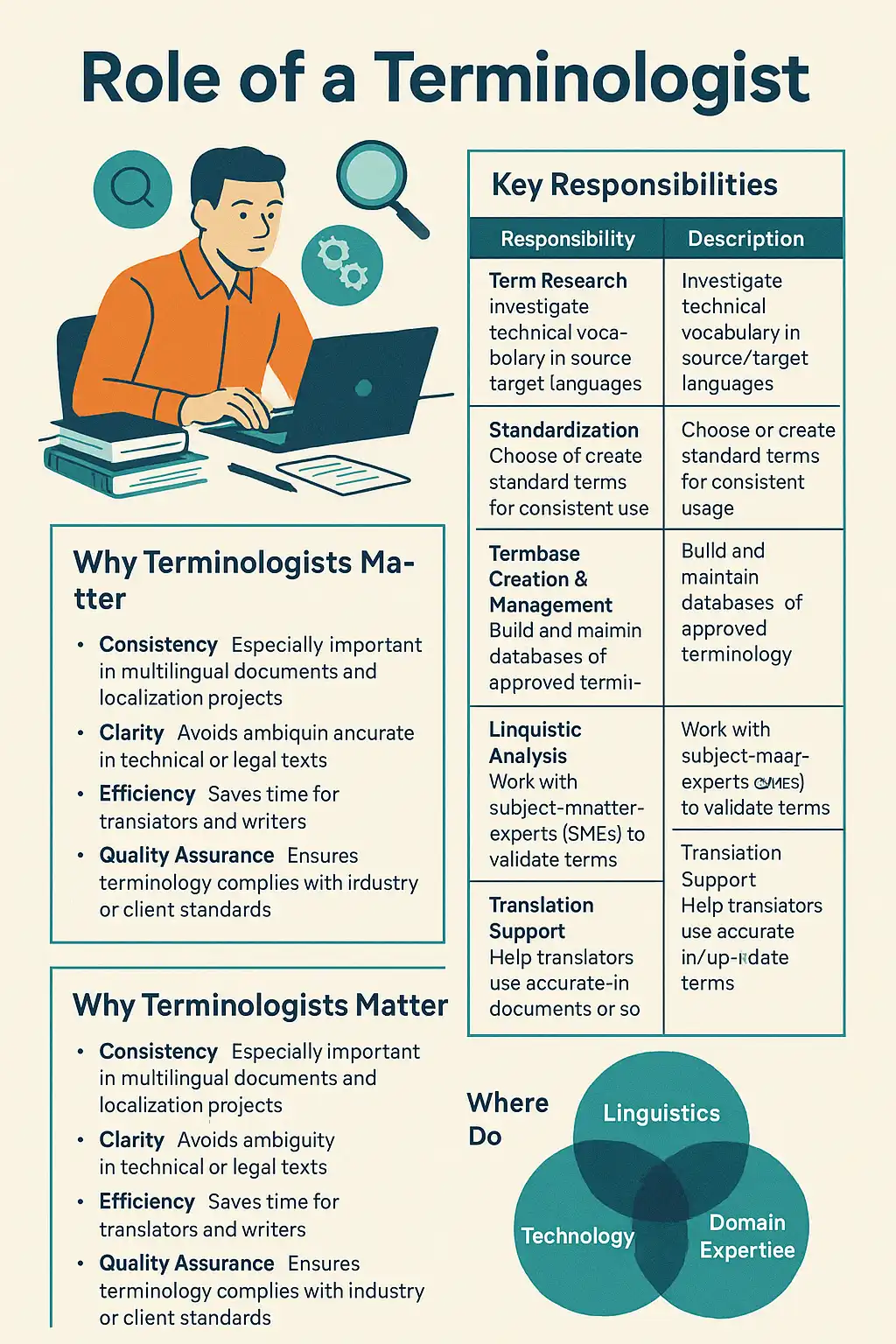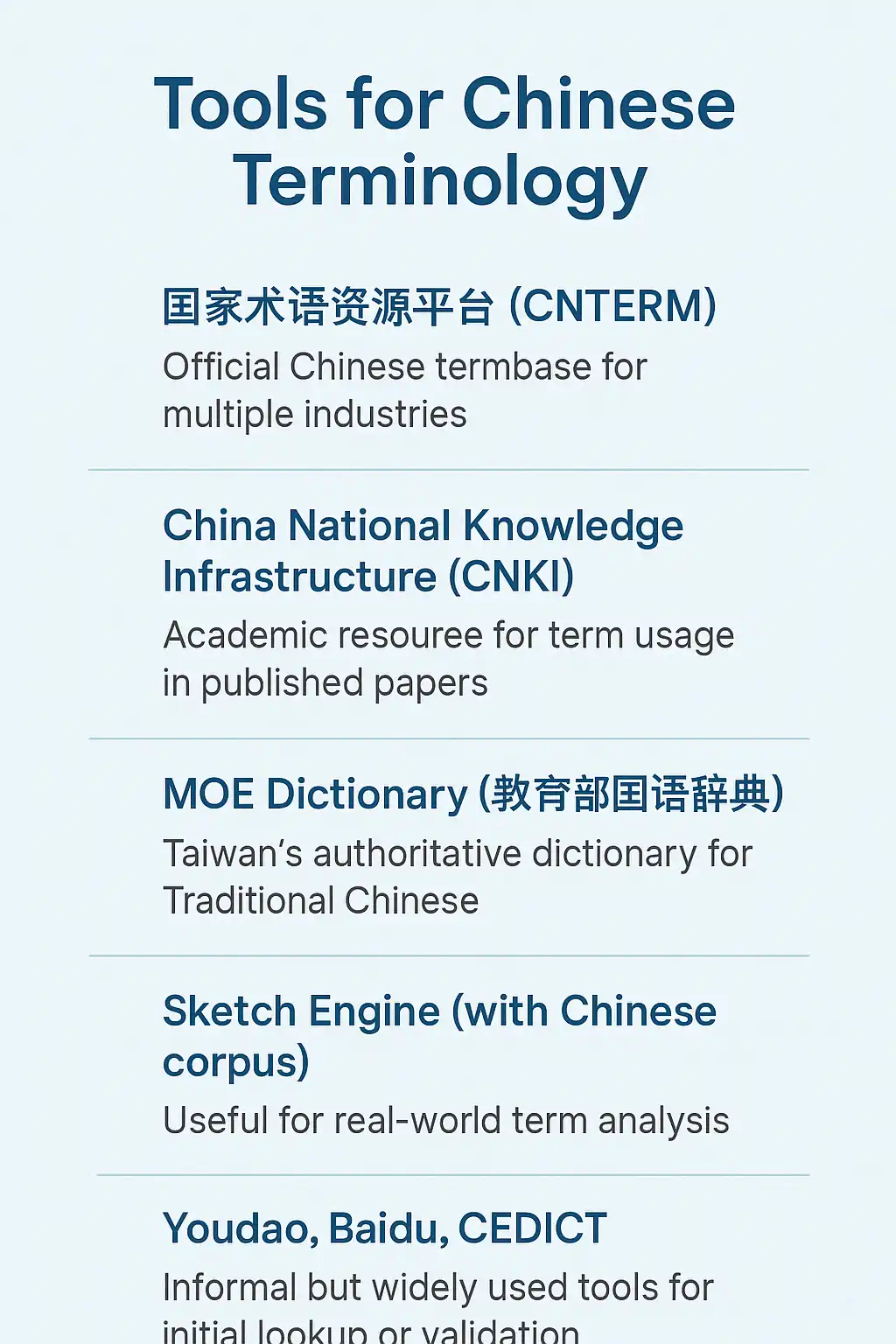And Why Your Project Needs One More Than You Think
Translation is often imagined as a straightforward word-for-word swap between languages. But in reality, the deeper you go—especially in fields like law, medicine, engineering, or software—the more one truth becomes clear: terminology can make or break your translation.
That’s where terminologists come in. They’re the behind-the-scenes specialists who ensure your message doesn’t just get translated—but lands with precision, consistency, and authority.
In this post, you’ll discover what terminologists actually do, how they differ from translators, and why they’re essential for any professional translation project involving complex or technical content.
What Does a Terminologist Do?
A terminologist is a language expert who identifies, researches, defines, and manages terms—especially in technical, legal, medical, or industry-specific domains. Think of them as linguistic librarians, but for high-value, high-risk vocabulary.
Their core tasks often include:
- Compiling termbases: organized collections of domain-specific vocabulary
- Defining concepts: not just what a term means, but how it’s used in context
- Ensuring consistency across all translated materials and languages
- Collaborating with translators, editors, and subject-matter experts
- Researching terminology through glossaries, academic sources, corpora, or even product documentation
Their goal? Ensure that “server,” “drive,” “bearing,” “seal,” or “appeal” means exactly what it’s supposed to mean—in the right industry, right context, and right language.

Why Can’t the Translator Just Handle Terminology?
Translators are often juggling tight deadlines, shifting client preferences, and multiple files. They may also work across a variety of subjects. In contrast, terminologists specialize deeply in one or more fields, and they spend their time building the foundations of linguistic clarity.
Here’s the key difference:
- A translator focuses on flowing, natural language that fits the context.
- A terminologist focuses on conceptual accuracy and technical precision.
On large projects, a translator referencing a verified termbase saves time, avoids errors, and delivers more professional results.
Where Terminologists Shine: Real-World Examples
1. Medical Translation
The difference between “myocardial infarction” and “heart attack” isn’t just academic. One is clinical, one is conversational. Terminologists help ensure the right tone and term are used depending on the audience—patient, doctor, or regulator.
2. Legal & Patent Work
Legal terms like “indemnity,” “statute,” or “injunction” carry very specific meanings. A misstep could render a document invalid—or worse, legally dangerous. Terminologists work with legal experts to build validated termbases that translators can trust.
3. Technical Manuals
A machine part might be called a “bushing” in automotive manuals, but a “sleeve” in industrial design. Terminologists ensure that once a term is chosen, it’s used consistently across all documentation, diagrams, and languages.
What Secret Tools Do Terminologists Use Behind the Scenes?
Terminologists rely on both linguistic intuition and specialized tools. Some of their most-used resources include:
| Tool Type | Description | Popular Tools / Examples |
|---|
| Termbases | Centralized databases for storing approved terminology | SDL MultiTerm, TermWeb |
| Corpus Analysis Tools | Help analyze how terms are used in real-world contexts | Sketch Engine, AntConc |
| Bilingual Dictionaries & Concordancers | Aid in verifying translations and usage across languages | Linguee, Reverso Context, WordReference |
| Style Guides & Controlled Language Systems | Ensure clarity, consistency, and simplicity in writing | Microsoft Style Guide, ASD-STE100 |
| QA (Quality Assurance) Tools | Automatically flag inconsistent or incorrect terminology in documents | Xbench, QA Distiller |
| Expert Consultation | Interviews or surveys with subject-matter experts to validate technical terms | Internal SME meetings, structured interviews |
They may also interview subject-matter experts or review source material from regulatory bodies or client documentation.
What’s Unique About a Chinese Language Terminologist?
| Area | Specific Features & Challenges |
|---|---|
| Script & Writing System | Chinese uses logographic characters, not an alphabet. A single term may look compact but carry layered meanings (e.g., 法律 – “law”). |
| Word Segmentation | Chinese doesn’t use spaces between words, so tools must accurately segment terms (e.g., 公共安全 could be “public safety” or parsed differently without context). |
| Terminology Formation | Many technical terms are formed through semantic translation (意译) or phonetic borrowing (音译). E.g., “laser” becomes 激光 (semantic: “excited light”). |
| Multiple Scripts & Standards | Must deal with both Simplified (Mainland) and Traditional Chinese (Taiwan, Hong Kong), plus regional variations in terminology. |
| Tone Sensitivity | Even if pronunciation is the same, tone and character choice matter—important for brand names, medical terms, etc. |
| Synonyms & Polysemy | A single English word can map to multiple Chinese terms based on domain. “Bank” could be 银行 (finance) or 河岸 (geography). |
| Culture-Specific Concepts | Concepts like 礼仪 (etiquette) or 道 (Taoism/way) carry deep cultural roots and need careful contextual adaptation in multilingual projects. |
| Input & Search Challenges | Must support Pinyin, Wubi, or handwritten input in databases—important when building termbases for Chinese users. |
| Character Count Limits | In UI/localization, Chinese is often more concise, but some terms may expand, affecting design and layout (e.g., 法律责任 = “legal liability”). |
| Tool Compatibility | Many Western CAT tools must be adapted to handle Chinese segmentation, encoding (UTF-8), and term matching effectively. |
🧰 Tools & Practices Specific to Chinese Terminology Work

👥 Real-World Roles
Chinese language terminologists often work in:

Chinese language terminologists often work in:
Patent translation & TMX curation
Localization & UX for tech giants (e.g., Apple, Huawei, Tencent)
Legal and regulatory translation
UN and government agencies
Academic publishing
The Business Value of Terminology Management
✅ Saves time: Fewer questions and corrections during the translation process
✅ Reduces cost: Especially over time, as validated termbases prevent rework
✅ Improves quality: Ensures the message is accurate, consistent, and aligned with brand voice
✅ Mitigates risk: Particularly in regulated industries, precise terminology avoids legal or technical errors
As a general rule, the earlier terminology is managed in a project, the smoother everything else goes.
Do You Always Need a Terminologist?
Not for everything. If you’re translating marketing materials for a local campaign, you may not need a dedicated terminologist.
But if you’re working on:
- A multilingual product manual
- International legal contracts
- Medical or pharmaceutical documentation
- Complex IT/software localization
- Patents or research papers
…then yes—you’ll want a terminologist on your team.
From building project-specific glossaries to managing multilingual termbases, we help businesses scale confidently and communicate precisely. Whether you’re rolling out a new device across 12 markets or localizing your legal documentation, our terminology experts have your back.
